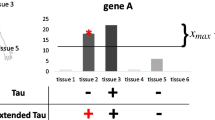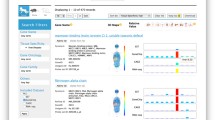Abstract
Gene expressions differ depending on tissue types and developmental stages. Analyzing how each gene is expressed is thus important. One way of analyzing gene expression patterns is to identify tissue-specific functions. This is useful for understanding how vital activities are performed. DNA microarray has been widely used to observe gene expressions exhaustively. However, comparing the expression value of a gene to that of other genes is impossible, as the gene expression value of a condition is measured as a proportion of that for the same gene under a control condition. We therefore could not determine whether one gene is more expressed than other genes. Cap analysis gene expression (CAGE) allows high-throughput analysis of gene expressions by counting the number of cDNAs of expressed genes. CAGE enables comparison of the expression value of the gene to that of other genes in the same tissue. In this study, we propose a method for exploring tissue-specific functions using data from CAGE. To identify tissue-specificity, one of the simplest ways is to assume that the function of the most expressed gene is regarded as the most tissue-specific. However, the most expressed gene in a tissue might highly express in all tissues, as seen with housekeeping genes. Functions of such genes cannot be tissue-specific. To remove these from consideration, we propose measuring tissue specificity of functions based on information content of gene ontology terms. We applied our method to data from 16 human tissues and 22 mouse tissues. The results from liver and prostate gland indicated that well-known functions of these tissues, such as functions related to signaling and muscle in prostate gland and immune function in liver, displayed high rank.




Similar content being viewed by others
References
Adams MD, Kelly JM et al (1991) Complementary DNA sequencing: expressed sequence tags and human genome project. Science 252:1651–1656
Collins FS, Morgan M, Patrinos A (2003) The human genome project: lessons from large-scale biology. Science 300:286–290
DeRisi JL, Iyer VR, Brouwn PO (1997) Exploring the metabolic and genetic control of gene expression on a genomic scale. Science 278:680–686
Frith MC, Wilming LG, Forrest A, Kawaji H, Tan SL, Wahlestedt C, Bajic VB, Kai C, Kawai J, Carninci P, Hayashizaki Y, Bailey TL, Huminiecki L (2006) Pseudo-messenger RNA: phantoms of the transcriptome. PLoS Genet 2(4):e23
Imahori IK, Tamio Y (eds) (1998) Dictionary of biochemistory, 3rd edn. Tokyo Kagaku Doujin, Tokyo
Ito K (ed) (1993) Encyclopedic dictionary of mathematics, 2nd edn. Informaton Theory. MIT, Cambridge, pp 810–815
Kasukawa T, Katayama S, Kawaji H, Suzuki H, Hume DA, Hayashizaki Y (2004) Construction of representative transcript and protein sets of human, mouse, and rat as a platform for their transcriptome and proteome analysis. Genomics 84:913–921
Kodozius R, Matsumura Y, Kasukawa T, Shimokawa K, Fukuda S et al (2004) Absolute expression values for mouse transcripts: re-annotation of the READ expression database by the use of CAGE and EST sequence tags. FEBS Lett 559:22–26
Schug J, Schuller W-P, Kappen C, Salbaum JM, Bucan M, Stoeckert CJ Jr (2005) Promoter features related to tissue specificity as measured by Shannon entropy. Genome Biol 6:R33
Shiraki T, Kondo S, Waki K, Kasukawa T et al (2003) Cap analysis gene expression for high-throughput analysis of transcriptional starting point and identification of promoter usage. Proc Natl Acad Sci USA 100:15776–15781
Spellman PT et al (1998) Comprehensive identification of cell cycle-regulated genes of the yeast saccharomyces cerevisiae by microarray hybridization. Mol Biol Cell 9:3273–3297
The FANTOM Consortium (2005) The transcriptional landscape of the mammalian genome. Science 309:1559–1563
The Gene Ontology Consortium (2001) Creating the gene ontology resource: design and implementation. Genome Res 11:1425–1433
Velculcscu VE et al (1995) Serial analysis of gene expression. Science 270:484–487
Author information
Authors and Affiliations
Corresponding author
Rights and permissions
About this article
Cite this article
Maekawa, S., Matsumoto, A., Takenaka, Y. et al. Tissue-specific functions based on information content of gene ontology using cap analysis gene expression. Med Bio Eng Comput 45, 1029–1036 (2007). https://doi.org/10.1007/s11517-007-0274-y
Received:
Accepted:
Published:
Issue Date:
DOI: https://doi.org/10.1007/s11517-007-0274-y




